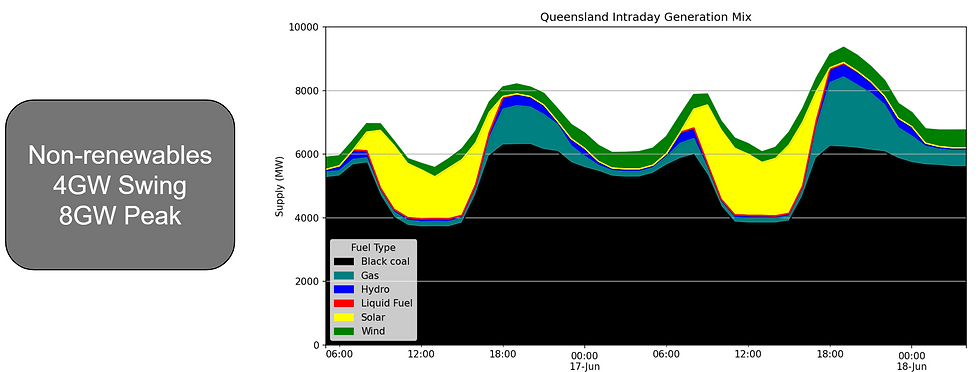
Australian households generate solar
they can't use when they need it most.
We're building the thermal infrastructure to fix that
designed here, made here, for conditions we understand.
Australia leads the world
in residential solar adoption
40% of houses generating
25 Gigawatts
of electricity from solar PV
But
there's a catch...

The sun goes away at night, so the grid wholesale price spikes to over $200/Megawatt

Solar is abundant in the day, so the grid gives away energy for FREE
The mismatch drives up electricity bills
and reduces the value of solar investments.

Households face rising costs and reduced solar ROI.
Market participants see instability in energy pricing.

We all rely on coal to balance supply and demand
This mismatch drives up electricity bills and reduces the value of solar investments. When demand peaks at dawn and dusk, you're buying expensive fossil fuel power. When your panels produce at midday, the grid pays you almost nothing—or charges you to export.


Don't take our word for it, look into

The Solar Squeeze:
Shrinking Returns and Rising Costs
Solar Export Price
(per kWh)
Grid Import Price
(per kWh)
2014:
$0.50
$0.20
2020:
$0.10
$0.25
2024:
-$0.01
$0.35
Rates for selling excess solar energy back to the grid continue to decline.
However, the new 'Sun Tax' will impose extra charges on exports.
Homeowners are left frustrated as their returns dwindle
paying more to import energy at night than they earn by exporting it during the day.
Why Batteries Fall Short for Homes
Residential batteries are often marketed as the go-to solution for energy storage,
but they face significant barriers for Australian households:
High Upfront Costs
Batteries cost $8,000–$15,000 installed, with federal rebates making them more accessible—but still a major investment with uncertain returns.
Degradation & Short Lifespan
Lithium batteries degrade within 10 years, losing capacity every cycle. You're replacing expensive infrastructure on a decade timeline, not building something that lasts.
Fire Risk & Safety Concerns
Fire hazards, installation restrictions, and extra costs for inverters and permits make batteries less appealing and more complex for residential applications.
Supply Chain Vulnerability
90% of batteries come from one country, exposing us to supply chain disruptions and fluctuating raw material costs (which account for 60% of battery production costs). Australia's energy future shouldn't depend on overseas coal-powered factories.
Thermal Dawn Mission:
Comfort Without Compromise
We engineer Australian thermal systems that free homes from rising bills
and transform distributed energy from grid burden to grid backbone.
Lower Energy Bills:
Shift usage to off-peak times and cut electricity costs by capturing your dawn solar abundance.
Maximise Solar ROI:
Use your solar power for heating, cooling, and hot water instead of exporting it for almost nothing.
Support the Grid:
Reduce peak demand and help stabilize Australia's energy system—one home at a time.
Sustainable Comfort:
Renewable energy fuels your heating and cooling year-round, with no lithium, no degradation, no fire risk.

Air Conditioning Drives Energy Demand
Heating, cooling, and water heating account for 60% of household energy use in Australia and peak during morning and evening hours, when solar power isn't available.
Bottom Line: Thermal Dawn captures dawn solar and stores it as heating, cooling, and hot water for when you actually need it—cutting bills, easing grid stress, and delivering comfort without compromise.
Case Study:
Stabilising Queensland’s Grid with Thermal Dawn


Queensland has one of the highest rates of solar adoption in Australia, yet grid instability remains a challenge. Thermal Dawn integrates seamlessly with Virtual Power Plants (VPPs), storing and releasing energy to stabilize the grid while lowering costs for homeowners.
If every home in Queensland with solar panels also had a Thermal Dawn system:

Peak daily energy swings would drop from 4GW to 2GW
2GW of coal power could be retired
By reducing peak demand and increasing self-consumption of solar energy, Thermal Dawn presents a scalable, cost-effective way to enhance grid stability and cut reliance on fossil fuels.

Describe your image

Describe your image

Describe your image
About Thermal Dawn
and Our Team



FreeVolt was founded by Nick Zeniou, an experienced Product and Engineering leader.
As an engineer in HVAC and large-scale energy generation, Nick saw a better path: engineer thermal storage for Australian conditions, using Australian materials.
From power stations to building plant rooms, Nick learned what keeps critical systems reliable: durability, serviceability, safety. Leading consumer software teams, he learned how to turn complex systems into simple experiences people actually use.
So Nick built a thermal battery designed for Australian homes—safer, more affordable, and made here.
Let's connect
